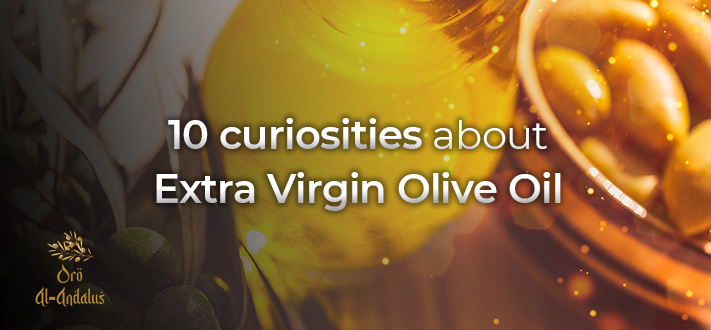Extra Virgin Olive Oil, as we already know, is the essential ingredient in the Mediterranean diet. It is an indispensable part of our daily nutrition and our culture. But what is the origin of its name? What is the recommended daily amount for consumption? This and much more in these 10 curiosities about Extra Virgin Olive Oil.
- The origin of extra virgin olive oil and an exact date are unknown. Mentions of oil and olive trees already appear in the Bible.
- The word “aceite” (oil) comes from the Arabic word “az-zait,” which means “olive juice.”

- The attribute “virgin” indicates that the extraction process was carried out exclusively by mechanical methods, without the use of solvents or chemical processes. The shorter the time between harvesting and production, the better and fresher the EVOO will be.
- Extra virgin olive oil has an acidity level of less than 0.8%, much lower than virgin olive oil, which can have an acidity level of up to 2%.
- It takes about 5 kg of olives to produce 1 liter of extra virgin olive oil. On average, the oil extracted from olives represents 20% of their weight, although this percentage can vary depending on the olives used.
- The timing of the harvest influences the quality of the oil. In fact, olives should be harvested at the stage of “envero.” During this period, they lose their green color and start to turn black-purple, resulting in a higher quality aroma and flavor. The oil harvested from early ripening olives is healthier due to its antioxidant compounds, and it is ideal for producing fruity oils with spicy notes.

- The color of the oil is completely irrelevant to its quality. In fact, quality is determined by the type of olive, the level of ripeness, and the extraction process. To confirm this, sensory analysis of oils is performed with blue-tinted glasses to hide the color.
- For optimal storage, it is preferable to use dark-colored containers. This way, the oil is not directly exposed to light, preserving its quality. The ideal temperature for storage is between 12 and 18 degrees Celsius, away from heat sources.
- The recommended intake is 2.3 tablespoons per day, preferably consumed raw to preserve its quality.
- Extra virgin olive oil is rich in polyphenols and antioxidants. These chemical compounds provide numerous health benefits, such as slowing down brain aging, combating cellular damage, heart diseases, hypertension, and even certain types of cancer.

If these 10 curiosities about Extra Virgin Olive Oil have sparked your interest in obtaining a quality oil, you should take a look at Oro Al-Andalus.
It is a Spanish oil with a unique flavor and aroma. Born in the “Serranía de Ronda”, in Andalusia, with fruity notes and a perfect balance between bitterness and spiciness, it will guarantee you a unique experience.
If you want to learn more, contact us at +34 690 613 790 or visit our website. You can also follow us on Instagram and Facebook to stay updated. See you soon!

